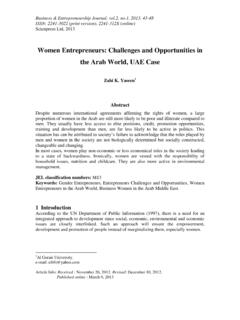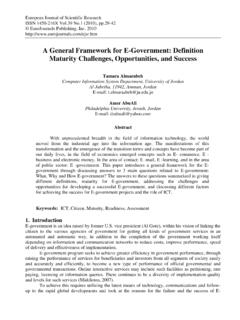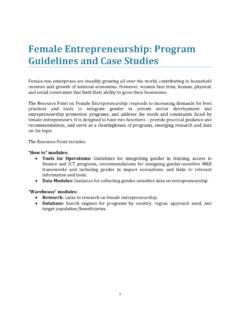Transcription of Minority-owned businesses in the United States: An ...
1 Journal of Management and Marketing Research Volume 21. Minority-owned businesses in the United States: An empirical analysis Granville M. Sawyer Jr. Bowie State University Falih M. Alsaaty Bowie State University Tolu Atanda Bowie State University ABSTRACT. This paper investigates the growth of Minority-owned businesses in the United States from 2002 to 2012 and assesses the market share of each minority group. minority entrepreneurs and business owners have different educational backgrounds, cultural orientation, managerial styles, and financial resources. Therefore, firms differ in terms of financial performance, market share, and potential growth. In aggregate, the firms achieved impressive increases in market share and sales revenue during the period under consideration. As far as new business creation is concerned, black or African American business owners were the most active in the market, fol- lowed by Hispanic business owners.
2 California, Texas, Florida, and New York were the homes for the great majority of Minority-owned firms. As is the case with white- owned firms, minority businesses contribute to the country's employment, innovation, investment and income. Federal and state agencies such as the Small Business Administration need to increase their efforts to support minority entrepreneur to start business ventures and, hence, contribute further to the country's progress and prosperity. Keywords: Minority-owned firms, small business, entrepreneurs, economic sectors, sales growth. Copyright statement: Authors retain the copyright to the manuscripts published in AABRI jour- nals. Please see the AABRI Copyright Policy at Minority-owned business, Page 1. Journal of Management and Marketing Research Volume 21. INTRODUCTION. Minority-owned business firms* have come to occupy an important place in the United States economy in recent years with a rapidly expanding role and economic influence.
3 The num- ber of minority firms reached million, or percent, of total firms in the country in 2012. The ratio of the firms to total firms was higher by about 6 percentage points than the ratio of mi- nority population to total population in the country. Although the great majority of the firms are very small with employment fewer than 20 people each they are engaged directly or indi- rectly in business activities in all sectors of the economy. Growth in the number and diversity of minority firms has occurred in spite of a variety of obstacles. Barriers included insufficient financial resources, inexperienced management, absence of strategic planning, and lack of familiarity with many attractive market opportunities, domesti- cally and internationally. The phrase Minority-owned firms is a comprehensive term that encompasses all kinds of business entities, including small firms with or without employees, large firms, high-technol- ogy firms, low-technology firms, resource-poor firms, resource-rich firms, locally-oriented firms, and internationally-oriented firms.
4 The Census Bureau classifies Minority-owned firms into five major categories of ownership: a. American Indian & Alaska Native;. b. Asian;. c. Black or African American;. d. Hispanic; and e. Native Hawaiian & other Pacific Islander. The ownership classification system indicated above implies that entrepreneurs and other business owners involved are of different cultural orientation, languages, skills, educational background, managerial style, and resource availability. Consequently, it is expected that the en- terprises they lead would largely be of different size, sector concentration, life span, growth po- tential, and organizational performance. Published official data show that in recent years black or African American- owned businesses were the fastest growing segment of Minority-owned firms, partly because of government programs designed to support small firms, and partly because of the fact that blacks or African Americans are the largest minority group in the country (about 13.)
5 Percent of the population). However, there are significant organizational performance differences among the firms in this as well as other categories. *. A Minority-owned business firm is defined as an enterprise that is at least 51 percent owned , operated, and controlled by an American citizen primarily from an ethnic minority group or, in the case of a publicly- owned enterprise, at least 51 percent of the enterprise's stock is owned by one or more such individuals. Minority-owned business, Page 2. Journal of Management and Marketing Research Volume 21. LITERATURE REVIEW. Minority-owned businesses have received increasing scholarly attention in recent years because of their growing contribution to economic progress and superiority. The prevailing feeling of many scholars, however, is that minority entrepreneurs and other business owners face many obstacles in their attempt to grow and expand their firms. For example, Bewaji, Yang, and Han (2015) argued that minority entrepreneurs are less likely to be able to access financial insti- tutions' business loans than nonminority entrepreneurs.
6 Walker (2009) and Reuben and Queen (2015) asserted that African Americans have a long history of entrepreneurial achievement. The authors added that African American- owned businesses suffer adversely from unequal access to capital markets with the prevalence of institutional barriers, a situation that threaten the survival of these businesses . Didia (2008), in studying the impact of the 1990s economic boom on Minority-owned businesses , concluded that these businesses lost ground in almost all industrial sectors. Bates and Robb (2013) found out that Minority-owned business (a) rely heavily on finan- cial institutions for loans, (b) experience higher borrowing cost than white firms, (c) receive smaller loans than they ask for, and (d) suffer higher rejection rates of loan applications. Christo- pher (1998) said that minority businesses , as compared to nonminority, experience a lower busi- ness formation rate and higher dissolution, and that black, Hispanic, and other minority business owners have historically encountered severe economic problems when forming and managing business firms, including inadequate financial resources and discrimination.
7 In comparing male- owned with female- owned firms, Adkins, Cheryl, and Samaras (2013) pointed out that studies have shown women business owners typically face greater business challenges than those faced by male business owners. In terms of business performance, Ortiz-Walters and Guis (2012) concluded that micro firms owned by Hispanic and black entrepreneurs were less likely to be profitable than nonmi- nority- owned micro firms. In examining employment growth and survival of minority -and women- owned firms, Jarmin, Krizan, and Luque (2014) found that, during the last Great Reces- sion in the United Stated, black- and women- owned firms underperformed white, male- owned businesses , while Asian- owned business outperformed other groups. On the other hand, His- panic- owned businesses outperformed non-Hispanic ones in respect to employment growth. In a research project about business success, Robb and Fairlie (2009) found out that Asian- owned businesses are more successful than white- owned businesses .
8 The authors added that reasons for the success could be attributed to the fact that Asian- owned firms have higher levels of human capital as well as substantial start-up capital. In investigating the factors that influence the performance of Minority-owned businesses , Cardon and Shinnar (2008) emphasized that minority entrepreneurs are a heterogeneous group of individuals, because they differ in terms of (a) motivation to engage in business activities, (b). business personal satisfaction, (c) business problems encountered, (d) size of business managed, and (e) income generated form the business. Wang and Li (2007) highlighted additional issues about the subject matter that included: (a) human capital attributes, (b) ethnic networking, (c) in- stitutional regulations, (d) societal institutions, and (e) discrimination. In explaining the motiva- tion of Korean immigrants to pursue entrepreneurial activities, In-Jin (1995) asserted that, be- cause of the language barrier and less transferrable education and occupational skills in Ameri- can labor market, many of them could not find white-collar occupations for which they had been Minority-owned business, Page 3.
9 Journal of Management and Marketing Research Volume 21. trained. Disadvantaged, many Korean immigrants became self-employed business owners. Ko- rean immigrants' middle-class background along with stable family structures and strong family ties helped them to realize their goal of becoming business owners. Moreover, social networks based on kinship, friendship, church membership, and school ties, provided potential business owners with financial assistance, training, business advice, and information about business op- portunities. Scholars have also investigated a variety of other issues related to Minority-owned busi- nesses. For instance, Lee et al (2015) studied the difference between minority business owners and nonminority business owners in terms of strategic adjustments. The authors found out that Mexican American and Korean American business owners deployed higher levels of strategic adjustment than African American and White business owners.
10 Grumbach and Mendoza (2008). indicated that African American, Latino, and American Indian owned businesses are greatly un- derrepresented in healthcare profession. The authors made a case for diversity in this area based on (a) civil rights equality, (b) public health needs, and (c) business gain. Edelman at el (2010). contended that black entrepreneurs are 50 percent more likely to engage in start-up activities than white entrepreneurs. On the other hand, black- owned firms are smaller and less profitable than their white- owned counterparts. Robichaud, Cachon, and McGraw (2015), in investigating the size and sector distribution of female- owned businesses , found out that the businesses tended to be less present in manufacturing sector and more in the service sector. Female owners were sig- nificantly older than their male counterparts and had longer tenure, in addition to managing smaller size businesses . Still, other issues related to Minority-owned businesses have been the focus of writers.

















